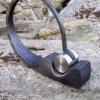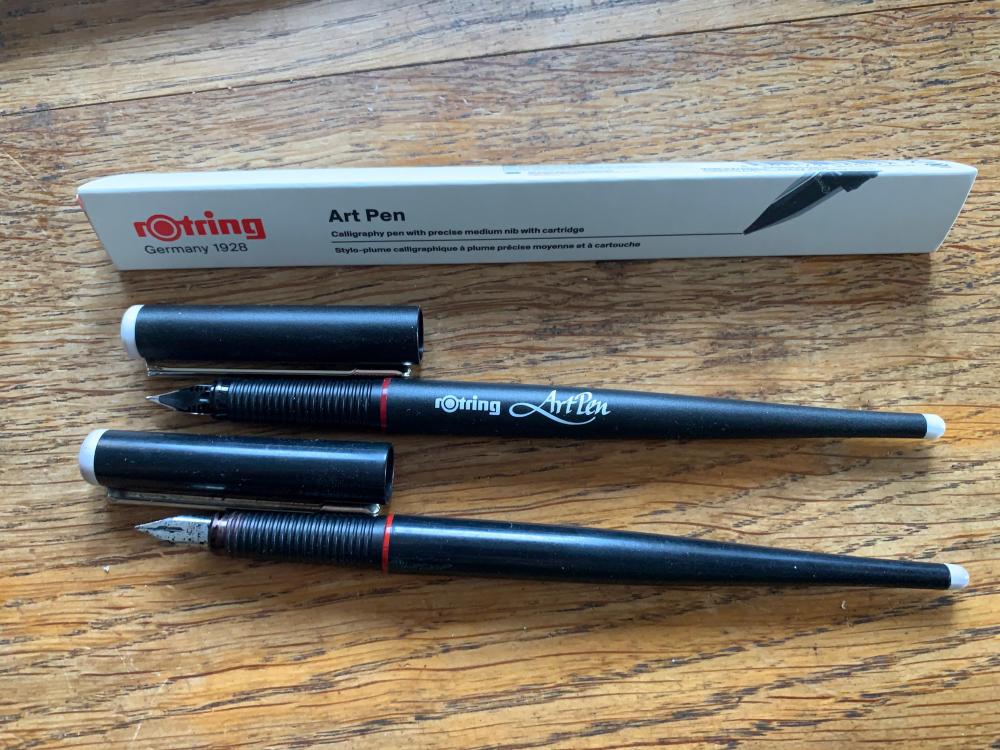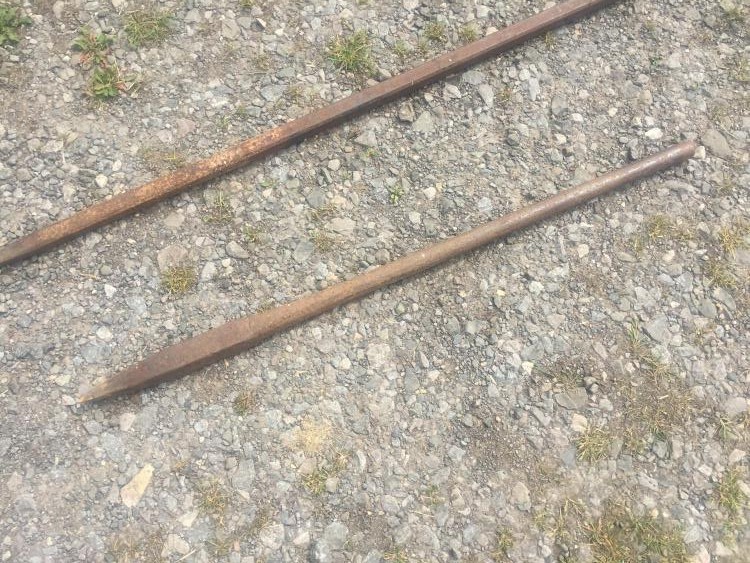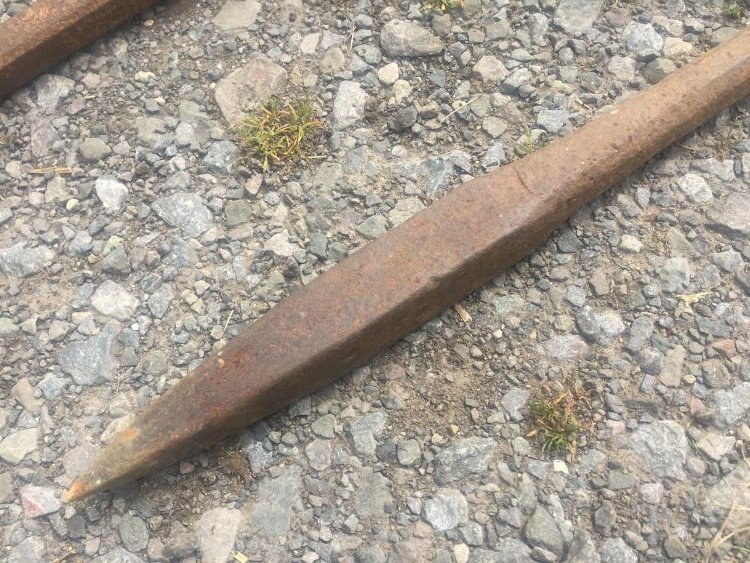-
Posts
1,990 -
Joined
-
Last visited
Content Type
Profiles
Forums
Articles
Gallery
Downloads
Events
Posts posted by Alan Evans
-
-
On 6/20/2020 at 8:56 AM, pnut said:
I've recently stepped into the 19th century and gotten a mechanical pencil but I still do a lot of sketching with a nib and holder you have to dip in ink like a quill.
I do most of my drawing (and writing) with a Rotring Fine nib Art Pen...lovely tool. Rotring made the Rapidograph fixed width technical drawing pens I used to use on Permatrace film and paper on the drawing board.
Coincidently, I have just this day taken delivery of a new Art Pen from Amazon. My old favourite has logged up over 30 odd years of daily use and is still going strong...I remember having it in 1988 when Buck Rogers set off...I remember that year because I called Snap! to David Petersen's identical Art Pen when he and I attended one of our preliminary meetings with the Welsh Arts Council preparing for the 1989 FIFI conference! Sadly it has developed a split in the cap which means it is not so safe to chuck into my carry bag any more...it is not a dipping system like yours but can use either cartridges, or as I do, a little plunger refillable reservoir. I thoroughly recommend them if you like drawing with ink.
Alan
-
It is almost surrounded by the formerly heavily industrialised Black Country boroughs to the west of Birmingham but is reckoned to be part of Birmingham. UK
-
Someone emailed me and said the link was broken and they were unable to download the handbook from here.
Here it is again in case it is of use to anybody else.
Alan
-
On 30/01/2018 at 2:44 AM, Steven Bronstein said:
while mixing a batch of Microcrystalline and Poly A Wax , I am running into a challenge. I melted the waxes together in a microwave and when thoroughly melted added thinner at the correct proportion. The challenge is that when adding the room temperature thinner, the wax immediately started to cool and not mix evenly with the thinner. I am hesitant to reheat the thinned solution , or preheat the thinner, because of the increased volatility and flammability of the thinner. Any suggestions?
another note, while mixing it as it cooled it did smooth out but I cannot tell how well it is mixed because both waxes are white. What the significance of an improper mix is I cannot say. My understanding is that the Poly A adds hardness to the wax finish. I have not tried just the Microcrystalline by itself. It still might be a big improvement over the stickiness of beeswax.
Is there any particular reason why you are not following the recipe I posted at the start of the thread?
Twice in the OP I wrote that you melt the wax then pour it into the White Spirit.
You describe trying to add the thinners to the molten wax...For reasons of safety using a similar logic to always adding acid to water...I aways add the hot wax to the volatile White Spirit in order to ensure that a small amount of of the White Spirit is not heated immediately to the temperature of the wax....a small amount of hot wax is added to the cooler body of White Spirit thus the volatile thinner is warmed very gradually and kept well below its flash point.
I have always poured and mixed on my own but with an assistant you could easily use a paint stirrer in an electric drill to blend smoothly.
Once the initial blending is done it is perfectly possible to thin the wax further with more White Spirit at room temperature with no further heating required. I have often found the wax is too thick when it is cooled so have diluted it down with more White Spirit. A paint stirrer would help that as well.
Alan
On 01/02/2018 at 2:03 PM, Daninghram said:Steve,
Did you buy the wax locally? I live in NH and was wondering where you got it?
Just research for wax manufacturers or suppliers. Contact the company I mentioned in the original post Poth Hille. They are in London but may well either ship to your country or have agents or colleagues there. Alternatively do a search for Museum/conservation supply businesses...
Alan
-
As someone who has worked with his hands all his life I am certainly not denigrating my fellow craftsmen. I am sorry my post has evidently come over that way.
This is a thread about relative hourly rates and job costing. I was trying to make a comparison between the investment in equipment and premises of a sole trader blacksmith and that of a sole trader who worked on site...ie had no premises overhead.
Electricians and plumbers were mentioned because of Kozzy's post earlier...the same comparison applies between any tradesman that can work from a tool bag and one that requires a premises and heavy equipment.
The qualifications, training and experience I took as being equivalent across the range of occupations. I think Steve misread my post. I realise that some industries are more regulated and qualified to higher levels than others, There is a lot of work going on over here to bring blacksmithing, especially restoration work, into a more coded and regulated occupation. Welding is the most advanced along that route. Farriery over here is not far behind. But the Art and Craft college courses, the traditional apprenticeships and the journeyman route for the Artist Blacksmith are not without some redeeming features. They have got us this far.
My post was intended as a series of questions which I hoped others could answer because of my ignorance, which Rockstar did admirably.
So I repeat it was meant to prompt an informative response not an affronted one...sorry it misfired.
Alan
-
And get back to coffee first!
Glad to hear it, well done!
Alan
-
It would be interesting to hear from any (jobbing/domestic) plumbers or electricians on here with a foot in both camps so to speak.
I have always marvelled at how much per hour they can charge for their time. Given the minimal investment in premises and equipment those trades have...and the narrow area of knowledge required relative to that of a jobbing metalworker / blacksmith, who as often as not are equipped and capable of basic plumbing and electrical work.
Maybe it is just their skill and experience which means although there is not much scope for creativity, the efficiency of their problem solving and labour means they can get a lot more done in that hour than a general handyman? So they are charging much the same as the handyman for the total job cost, but they just get it done quicker?
Maybe they just charge a lot because they can.
Playing to our strengths, having invested in machinery and premises, we either have to be economic through batch production or along the Art route where the singularity of the work has a premium. 25 years ago Tom Joyce and I agreed that 1500 was the minimum cost for a project we could take on economically. Dollars for him and pounds for me.
Alan
ps thinking about it a bit more I suppose the specialism of the trade is an equivalent to the efficiency of batch production economics...A jobbing welder with a truck and a single machine, even if charging only the same rate as me who has 5 welding machines and a building to house them, will certainly be more profitable.
-
5 hours ago, Smoggy said:
Then when we use those same lathe tools in our shaper and get to rename them to add to the confusion.....!

looking forward to seeing this axe finished,
Could you use those in a shaper? The ones on the old machine I knew, I remember as being much heavier top to bottom (or in shaper terms front to back).
I hated the machine...but Angus my fellow student loved it. I was always waiting for it to go bang...to be fair it never did.
Alan
-
2 hours ago, Gergely said:
Yeah, it's gonna be pretty hard to forge back into the original shape

Hi Frosty! I'm not really familiar with the special names of lathe tools. It was like the longest one in the picture below:
It sparked like 1045-1055 plain medium carbon steel. I have a big bunch of old lathe tools and I like them for sheperd's axes and stuff.
I had some trouble with the beard going in to far. Now it's okay. Next time I'll remember to leave longer neck between the blade part and the hole.
Bests:
Gergely
I think only the long one is a boring bar. The others are just standard left, facing, parting/grooving, thread cutting(?) and right. With the paint I presume that they are tipped with either HSS or carbide depending on their generation.
Alan
-
2 hours ago, JHCC said:
And some of them were very odd indeed.
You misunderstand me...I was referring to the years indivisible by two.

Alan
-
1 hour ago, JHCC said:
Is the "Brazilian gallon" similar to an Imperial gallon, but left over from the period between 1822 and 1889?
I thought it sounded like something to do with a distopian film by one of the old Monty Python team.
Alan
-
One of the advantages of that tuning fork idea is that you could build in a clamp for an end stop...I usually put a mark on the floor to align the bolt cutter and have an Immoveable object the appropriate distance away to feed the bar to.....or just chalk mark the lengths onto the bar.
However I have to say that I have used the bolt croppers fairly infrequently over the last 40 odd years so maybe I will just carry on using them on an ad hoc basis!
Alan
-
1 hour ago, ianinsa said:
well I'm just a poor African so I try no to buy a Brazilian gallons of vinegar, I would pop about 2 litres (say 4 pints of vinegar in a plastic bag put my thingamabob in said bag and immerse in a wheelie bin or suitable drum of water, this will evenly distribute the vinegar evenly around your thingamabob and save you a goodly portion of that Brazilian gallons of vinegar.
p.s. that resultant "galvenegar is really good for pouring down unwelcome ant nests! it might not win you brownie points with the sierra club though. but won't bring Greenpeace kicking down your door.

What a clever man you are! That is a very interesting concept I will log away for the future.
I make up phosphoric acid pickling tanks with sheets of polythene laid onto 4x2 timbers....or whatever suits the project...
I make clear polythene sheet envelopes sealed up with duct tape to contain the media so I can recycle it when shot blasting objects too big for the cabinet.
I use a glass jar to contain brass, citric acid and detergent to isolate the dirty / cleaning solution from the transmission solution in the Ultrasonic Cleaner tank...maybe I will try that in a polythene bag, it will probably transfer the sound waves better as well.
Thank you Ian.
Alan
-
4 hours ago, JHCC said:
Lou, this gives me an idea: take a ~12" piece of black pipe (say, 2½"-3" diameter) and forge into a rough oval. You want something that will fit over the handle and slight tightly just below the pivot.
That looks an interesting idea.
The two reasons I use it at floor level however are; that resting it on the ground means most of your body weight is above it, which means less effort required; that the floor acts as a continuous trestle and supports however long the standing bar or cut off piece may be.
These two points are especially handy when working solo. Both ends of the bar always jump when you go through, and invariably the longest end falls off the bench. It also means you did not have to lift it onto the bench or trestle in the first place!
I have made it into a proto guillotine by clamping one handle in the vice in the past. It works well if you have an assistant holding the bar.
I have only referred in jest to myself or my assistants when supporting one end of a bar as "an intelligent trestle"...I am very PC really.
Alan
-
On May 20, 2017 at 6:03 PM, Lou L said:
I just showed (the 44 inch bolt cutters) to JHCC a few days ago. I'm trying to figure out how to set it up in a stand or jig so I can use it. It chews through some pretty thick stock.
My pair of those I usually use with the jaw and one handle resting on the ground, especially if I am feeding a long bar though it for multiple cuts.
Alan
-
7 minutes ago, Dave51B said:
Is there some kind of ratio I could use to mix up a batch? Thanks Dave
I use flake graphite for both burnished paint finishes and punching/drifting lubricant. Rocol sold it as Foliac 4B. My last sackful came from a graphite dealer, David Hart Feckenham, Worcestershire. There must be one or two suppliers in most countries. Same sack has lasted 20 years!
I used to mix it with my homemade Renaissance wax (Microcrystalline and Polythene waxes in White Spirit) because that is what I had around. The wax just acts as a carrier to hold the graphite onto the punch or drift so the ratio is largely immaterial...basically as much graphite as you can get in. In an open pot the white spirit evaporates so you need to thin it down occasionally. The last few years I have been mixing the graphite with Molyslip brand MWL which stays gloopy almost indefinitely. Not nearly as pleasant a smell as the wax when it burns off however.
Alan
-
4 hours ago, Frosty said:
Might want halter people will start to bale.
I agree, we don't want to stirrup any trouble.
Alan
-
Mustang on to my sanity here. And before any of you ask, I don't believe in Sanity Clause.
I know it is not much use to shut the stable door after the horse has bolted it.
...but...
When I said I could not find a source of supply of horse hide I did not mean I didn't know where they came from...trouble is all the ones I knew of already had an occupant.
In order to rein in your irreverent (and irrelevant) horsey talk and curb your enthusiasm I will relate a serious horsey experience which should stall the proceedings a bit.
(...ooh got four in that line!)
One of my major public appearances was as a pall bearer for one of the most famous horse riders ever. Pat Smythe was an Olympic show jumper in the fifties and sixties. She was our local hero, she happened to give a home to an orphaned young man who became a blacksmith who in turn gave me a holiday job at age 16.
Coincidently we are taking him out to lunch on his 75 birthday next week. So I trust you will all wish him a happy birthday.
He is the only current holder of a gold medal from Worshipful Company of Blacksmiths. How about that?
Off to hit the hay now...
Alan
-
Thinking about it you probably would not need the hard steel tip for an ice breaker...but I dare say no one would have two such things, one soft specifically for ice when the hard ground one would do both jobs!
Bit like that song from Fiddlers Roof...one staircase for going up, one for going down, and one of them going nowhere just for show!
Alan
-
2 hours ago, Mberghorn said:
So that's what that is. I grabbed a couple of these from my grandfather's garage when he passed but since he lived on the coast of Lake Ontario fairly close to Canada, I just figured they were ice breakers.
Could well be an ice breaker. We even have some relatives dotted around Canadia from both my parents families...but I doubt they would have bothered to ship that back!
Good for whatever digging was required in hard ground. All the weight at the pointed end makes it easier to hit the same point of impact with the subsequent stabs. Well for me at least!
Alan
-
Following on from a digression on another thread (enormous tongs) I thought some may be interested in a beautifully balanced blacksmith made Post Hole digging bar I inherited from my father.
It is 1016mm (40") overall length and fire-welded up from three pieces. You can see one of the scarf traces on the transition between head and shaft.
Ø28mm (1.125") for the shaft, which was upset over a few inches, and 38mm (1.5") square for the head, both wrought iron, and it is tipped with a bit of (blister?) steel.
Alan
-
9 hours ago, WayneCoeArtistBlacksmith said:
Alan, with the new pictures they wouldn't do very well as post hole diggers. Here in the US post hole diggers have about a 6" diameter bits and thin. I make fire place shovels from 1" square and have a shovel face about 6" wide, So I think maybe a little bit larger than 1" would make bits beefy enough to work well. I may try making some and let you all know. I would probably draw out the handles though normally they are wooden which tend to break after a while.
Wayne
Although I had forgotten just how heavy they were, I knew they were too heavy for post holing and thought you were joking...hence my jokey response!
It was good exercise for me yesterday nonetheless!...physically to get them out into the sunshine...and mentally to try and figure out the making sequence. Quite a different set of shapes to the traditional "near anvil edge; quarter turn-far anvil edge; quarter turn-far anvil edge" hand forged tong process.
I guess the reason the store bought wooden handled post hole "hinged trowel devices" are lightly built is that they are intended mainly just for lifting out the spoil loosened by a bar or pick. They are certainly no good for digging in the stoney ground round here.
Depending on the post size I have used an auger with a Tee bar as opposed to hiring a powered one. But even they struggle with our Cotswold Brash. But often as not for the occasional hole just use a bar and a single blade post hole spade and my hand! A few years ago I did repair a tractor mounted post hole hammer for an agricultural contractor...that was a brutal device...but very quick if you are fencing a field.
Alan
Talking of Post Hole bars reminded me of the beautifully balanced blacksmith made one I have inherited from my father....I have started another thread with a couple of photos.
https://www.iforgeiron.com/topic/51374-forged-post-hole-digging-bar/#comment-543801
-
Neigh, neigh and thrice neigh, I don't believe any of you.
Your just telling tall tails.
Alan
-
11 minutes ago, Melw45 said:
It is a split leather and i dont think saddle soap will work on it.
At $10.00 if it starts bothering me i will replace it.
Mel
The best one I have seen was owned/used by Alan Knight, the blacksmith I trained with. It was from horse hide. Very smooth so it shed the dirt. He had something of a belly and over the years his apron took on his convex shape!
Sadly I never found a source of supply for horse hide.
Alan





Understanding CWT
in Power Hammers, Treadle Hammers, Olivers
Posted
Grand looking machines, are they running on steam or converted to air? There does not appear to be any lagging on the delivery pipes...
Best bet would be to ask John Nicholson of Massey in UK. http://www.masseyforging.com/home.htm
The pressure of steam or air acting on the diameter of the piston are the starting point, but only give you the same result as for a hydraulic press. Crucially the length of stroke it accelerates through will have the greatest effect on the effectiveness of the hammer.
Perhaps next best bet is to look at the Massey hammer brochure which shows that the 40CWT Clear Space Air Hammer generates a blow energy of 6,400kgm
Hope that helps, Alan